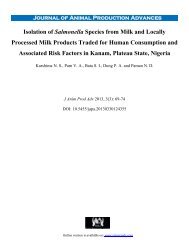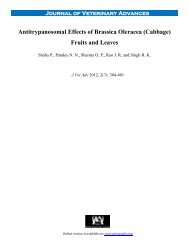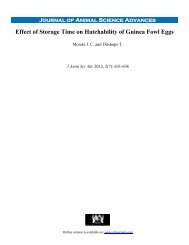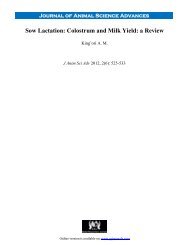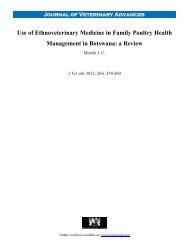You also want an ePaper? Increase the reach of your titles
YUMPU automatically turns print PDFs into web optimized ePapers that Google loves.
EGG QUALITY DEFFECTS: TYPES, CAUSES AND OCCURRENCE …<br />
Introduction<br />
Egg quality is a general term that relates to<br />
various external and internal standards that are<br />
imposed on the eggs (Koelkebeck, 2003). Some of<br />
these standards are based on subjective measures of<br />
egg quality and some are based on a more<br />
quantitative measure of egg quality. Egg quality has<br />
an influence on egg acceptance or rejection by the<br />
consumer. Egg quality defects are deviations in<br />
external and internal standards of the egg that affect<br />
the quality. Exterior quality includes egg weight,<br />
egg shape, colour, shell thickness, shell weight,<br />
shell density, texture, egg surface area, and<br />
cleanliness (USDA, 2000; Hussain, 2011). The eggs<br />
should be uniform in colour, size and shape. The<br />
shell of each egg should be smooth, clean and free<br />
of cracks. Egg weight, shape and colour are external<br />
characteristics that influence grading, price,<br />
consumer preference and hatchability (King’ori,<br />
2011; 2012). Poor eggshell quality has been of<br />
major economic concern to commercial egg<br />
producers (Washburn, 1982; Roland, 1988).<br />
Information from egg grading facilities indicates<br />
that 10% of eggs are downgraded due to egg shell<br />
quality deffects. Internal quality refers to egg white<br />
(albumen) cleanliness and viscosity, size of the air<br />
cell, yolk shape and yolk strength and involves<br />
functional, aesthetic and microbiological properties<br />
of the egg yolk and albumen. The proportions of<br />
components for fresh egg are 32% yolk, 58%<br />
albumen and 10% shell (Encyclopedia Britannica,<br />
2012). Egg albumen is the clear liquid contained<br />
within an egg. Its primary purpose is to protect the<br />
egg yolk and provide additional nutrition for the<br />
growth of the embryo. It is rich in proteins and<br />
contains almost no fat, unlike the egg yolk, which<br />
has a high fat value. The egg yolk is the yellow<br />
spherical part of an egg that is surrounded by the<br />
albumen. It is the part of the egg which feeds the<br />
developing embryo. The poultry egg is of a high<br />
nutritional value to man that is mainly attributed to<br />
egg albumen and egg yolk which are the edible<br />
components. They supply all essential amino acids<br />
for humans, and provide several vitamins and<br />
minerals, including retinol (vitamin A), riboflavin<br />
(vitamin B 2 ), folic acid (vitamin B9), vitamin B6,<br />
vitamin B12, choline, iron, calcium, phosphorous<br />
351 J. Anim. Prod. Adv., 2012, 2(8):350-357<br />
and potassium. The egg has chemicals and<br />
components (Froning, 1998) that have multiple uses<br />
in biotechnology, chemical, food, pharmaceutical<br />
and art (painting and photography) industries (Egg<br />
Tempera painting, 2011; Germadios et al, 1996;<br />
Messier, 1991).<br />
In the production of poultry eggs, the aim is to<br />
produce eggs with a high hatchability, consumer<br />
preference, and of the best grade that fetch the<br />
highest price (King’ori, 2011, 2012). However,<br />
there are certain defects that affect negatively the<br />
external and internal quality of the egg causing<br />
losses to the producer, retailer and consumer. It is<br />
therefore important to understand the external and<br />
internal egg defects, their causes and economic<br />
importance. Understanding the various egg quality<br />
deffects and their causes will assist in designing and<br />
implementing measures to minimize their<br />
occurrence, hence reducing losses in the egg value<br />
chain. This paper reviews the egg quality defects,<br />
their causes, possible solutions and economic<br />
importance.<br />
Types of Egg Deffects<br />
External defects<br />
Exterior measurements (i.e. measurements<br />
made without breaking or piercing the shell) have<br />
traditionally been done by visual inspection of the<br />
outer surface of an intact egg, to search for cracks,<br />
and by candling. However, a system with a high<br />
precision using a laser scan to detect cracks,<br />
pinholes, and thin regions in the shell has been<br />
developed - U.S. Pat. No. 5,615,777 (Or-Yehuda,<br />
2007). External egg quality deffects include shell<br />
quality, cleanliness, shape, texture and soundness<br />
(Jacqueline et al, 2011).<br />
Shell quality<br />
To the human eye, the shell of the egg appears<br />
to be a homogeneous structure with uniform<br />
composition throughout. When observed under high<br />
magnification, the structure is extraordinarily<br />
complex. It has at least six significantly different<br />
layers beginning with two shell membranes between<br />
the albumen and the interior surface of the shell.<br />
These layers are followed by three regions of<br />
calcified materials, and completed with a thin<br />
organic material on the outer surface called the




